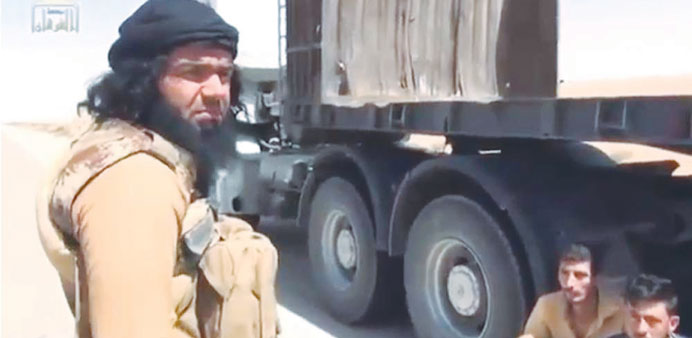AFP/Baghdad
A video showing the execution of Syrian truck drivers in western Iraq has revived fears of Al Qaeda-controlled bastions along the route, this time with a new face to the militancy.
The highway cutting through Anbar province and connecting Baghdad to neighbours Jordan and Syria was long considered one of the most dangerous in Iraq, with the vast adjoining desert providing refuge for militants, including groups linked to Al Qaeda.
But those fears had eased in recent years.
As violence has worsened nationwide to levels not seen since 2008, though, and amid fears neighbouring Syria’s conflict is spilling over into Iraq, the cold-blooded killing of the truck drivers has brought back memories of the country’s brutal all-out sectarian war in 2006 and 2007.
Then the name Abu Musab al-Zarqawi, leader of Al Qaeda’s front group in Iraq at the time, sparked widespread fear, but this time an online video depicting the murders puts a new name to the violence: Shaker Wahiyib al-Fahdawi.
“He is the only one who kills without covering his face, and is working on declaring an Islamic state,” said Colonel Yassin Dwaij, head of Anbar province’s police intelligence.
“He is dangerous and cunning.”
The video, posted online on August 25, depicts the events of a June 2 attack. At the time, AFP sources said militants killed three truck drivers and set their trucks ablaze along the Anbar highway.
Fahdawi was shown in the video questioning four truck drivers in an attempt to determine their sectarian identity.
Three initially claimed they were Sunni in an attempt to appease their captors, but were eventually found to be Alawites, the sect of Syrian President Bashar al-Assad, whom rebel groups—including those linked to Al Qaeda—have fought to oust.
Fahdawi then lined up the three along the highway and gunned them down. A fourth was set free after having been determined to be Sunni.
Throughout the video, the militants appeared to show no regard for the possibility of security forces chancing upon them, despite the fact that their operation was taking place over several minutes, in broad daylight, on a major highway.
Fahdawi also showed no apparent fear of being identified—while all the other gun-toting militants in the video had their faces covered in cloth, Fahdawi’s face was clearly visible as he questioned the drivers before killing them.
In the video, he sported an appearance that has become synonymous with jihadist militants—baggy trousers, a long beard with a shaved moustache and a headscarf.
It is the latest in a sudden rise to prominence for the 27-year-old, who was held by US forces in the notorious Bucca detention camp in southern Iraq before being sentenced to death and imprisoned in Salaheddin province in the north.
He broke out of jail last year and has since been on the run.
In recent months, however, he has become more brazen in his public appearances, and officials have blamed him for a litany of terror-related offences.
Piggybacking on anti-government protests that have raged in his native Anbar since December, Fahdawi was shown in online videos reading a poem at a demonstration in Fallujah in March.
Anbar security officials swiftly put a $50,000 bounty on his head, but little progress appears to have been made.
Two months later, they blamed him for leading militants in kidnapping 16 policemen along the Iraq-Jordan highway in Anbar, leaving 12 of them dead and four wounded.
As the video of the truck driver killings has been more widely broadcast, including on state television, Fahdawi has become arguably one of the most visible faces of Al Qaeda-linked militancy in Iraq since Zarqawi.
“The terrorist who killed the truck drivers ... is one of the most dangerous Al Qaeda figures today,” said an army major general, speaking on condition of anonymity.
“He forms part of the new generation, representing some of Al Qaeda’s former figures like Zarqawi, but even more extremist.”
Zarqawi, a Jordanian national, was notorious for his brutal tactics which eventually turned Sunni tribes in Anbar against him, helping shift the balance of Iraq’s bloody insurgency, and he even clashed with Al Qaeda’s central leadership.
Before he was eventually killed in an American airstrike in June 2006, he was often shown in online videos leading militant training camps, firing automatic rifles into the air.

Fahdawi was shown in the video questioning four truck drivers in an attempt to determine their sectarian identity
